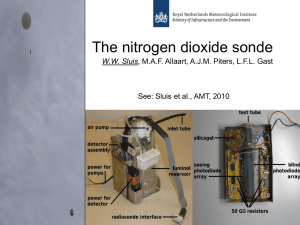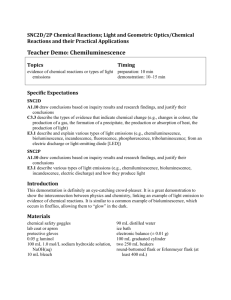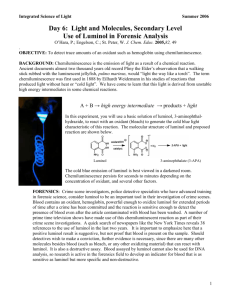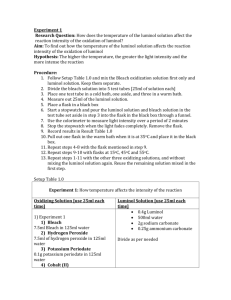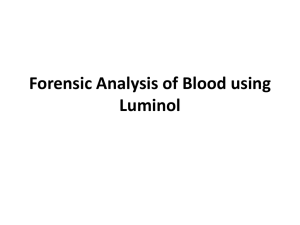LUMINOL & BLUESTAR - OldForensics 2012-2013
advertisement
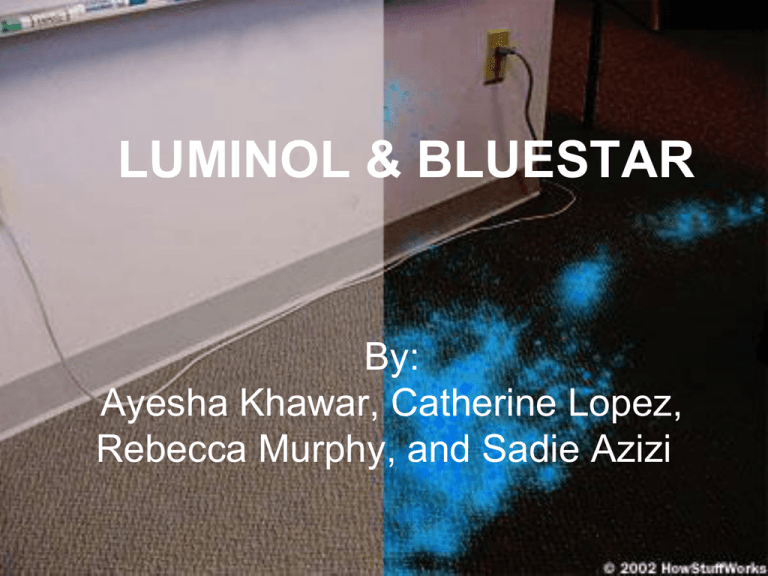
LUMINOL & BLUESTAR By: Ayesha Khawar, Catherine Lopez, Rebecca Murphy, and Sadie Azizi HISTORY • • • • • Luminol is a liquid solution that is sprayed to reveal traces of blood at crime scenes. Several chemicals in luminol react with the hemoglobin found on the crime scene, resulting in a light-producing chemical reaction. Luminol was first synthesized in 1853, but it wasn't really useful for chemists back then. Then, in 1928, German chemist H. O. Albrecht found out that adding hydrogen peroxide to luminol produces a bluish-green glow. Specht conducted the first few experiments HISTORY • In 1951, Grodsky combined powders made up of luminol, sodium carbonate, and sodium perborate, which was mixed with distilled water. o • The problem with this formula was that the sodium carbonate produced a slow reaction in hemoglobin's oxidation process, which lead to a brief duration. Then a new formula was created in 1966 by Weber. He used luminol, sodium hydroxide or potassium hydroxide, and hydrogen peroxide diluted in distilled water. o This solution had a short lifespan. It would only show the luminous reaction when there is complete HISTORY CONTINUED • • • • BlueStar is a new reagent that detects blood. Even though it's based on luminol, it works more effectively than luminol. Jean-Marc Lefebvre-Despeaux appointed Loic Blum to find a new luminol-based formula that didn't have the problems from previous formulas. The advantages of BlueStar: glows brighter than luminol, lasts longer than luminol, and the room doesn't have to be completely dark HOW LUMINOL WORKS • • HEMOGLOBIN is the oxygen carrying protein in BLOOD There is a LIGHT producing CHEMICAL reaction between the chemicals found in luminol and the hemoglobin in the blood • Because the reactants have MORE energy than the products, the excess energy is given off in the form of visible light protons • This light can be seen in a room that is completely dark HOW BLUESTAR WORKS • • • • A relatively new, LUMINOL based visualizing agent Usually found in tablet form and made easy to dissolve Easy to use at a crime scene Once Bluestar has been sprayed, the reaction occurs immediately (similar to the luminol reaction) and can be seen WITHOUT complete darkness LUMINOL AND BLUESTAR CONTINUED o Neither luminol nor Bluestar interfere with any DNA testing of the blood o Both are able to detect bloodstains diluted as little as 1 in 100,000 Luminol Disadvantages Advantages is not the only substance that is • It reacts with blood without • Blood triggered by Luminol. • • • being mixed with any other oxidizing agent. It wears off in 30 seconds, preventing testing substances from glowing for a long time period. ability to detect trace amounts of blood many years old, even if the surface was cleaned. any area sprayed can be photographed for permanent evidence. • • • o copper, bleach, urine, and animal blood are also possibilities. Prevents other tests from being performed on the item it has been sprayed on. o DNA can still be extracted for further tests. Fluorescent must be observed in a dark room, and observation window is really short. Has been identified as a possible carcinogen. o A substance capable of causing cancer. BlueStar Advantages • • • • • • Does not alter DNA and allows DNA and ABO typing. Sensitivity allows the naked eye to detect bloodstains as diluted as 1:10,000. Easier and safer to prepare. o tablets, kits,etc. No alternative light source needed. Room does not need to be completely dark. Glows longer than Luminol. Disadvantages • • • • Lasts for a short period of time. o about 45-60 seconds. Small chance of testing positive for certain metal ions. The lighting must be right and not too light. Excluding DNA, it prevents other tests Luminol Vs Bluestar Cases Involving Bluestar and Luminol Luminol reveals substances such as blood, which allows it to be tested for DNA, the glowing that is produced by Luminol's reaction with the substance can leave a trace of where the blood came from and where it went. A case where Bluestar was used was in the case of a South African man who, out of a jealous rage, murdered his wife's lover. They tried to clean up the mess but the traces of blood could not hide from Bluestar, they found the same blood at many places in the house and in the vehicle of the murderer. Cases Continued.. Another case involving the use of bluestar is that of a man that was murdered in his apartment, his friend was allegedly asleep on the couch and did not witness anything but only got to say goodbye to his friend as he died, investigators arrived and used bluestar on the friend and found blood traces all over his arms. Luminol Case One case that was very important world wide which used luminol to help solve it was that of the murder of Meredith Kercher, she was murdered in Perugia, Italy in 2007 by her roommate and her roommates boyfriend along with a friend of the roommate. The luminol was used to detect bodily fluids and footprints from the two males that sexually assaulted her and from her roommate. Sources http://science.howstuffworks.com/luminol1.htm http://www.bookrags.com/research/luminol-chmc/ http://www.bluestar-forensic.com/index.php http://news.softpedia.com/news/How-Luminol-Works-89369.shtml http://www.bluestar-forensic.com/pdf/en/JFI_56__bluestar_luminol_comparison.pdf http://www.tech-faq.com/luminol.html http://www.doctorcsi.com/blue-star-forensic/ http://www.bluestar-forensic.com/gb/bluestar-chemistry.php http://truejustice.org/ee/index.php http://www.bluestar-forensic.com/gb/bluestar-cases.php
